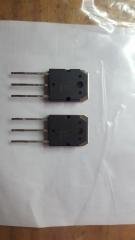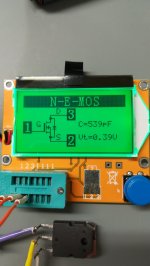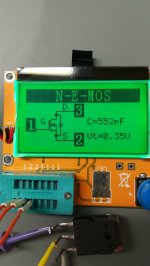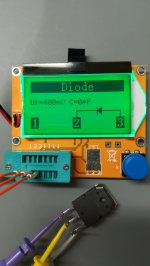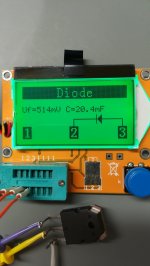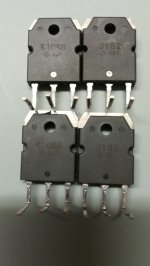Hello.
I bought a couple of 2sj162 /2sk1058 from amazon, marked as original.
The price was for each 5E that is, more or less, what one has to pay for a RENESAS original lateral FET.
As soon as I started to make the first test with the 2sj162 I was disappointed finding that the Source Pin of the 2sj162 is on Pin3 and not on Pin2 (the middle one).
I did the test with two digital voltmeters put on measuring the diode forward voltage.
The first instrument I used to measure the protection diode drop voltage from Drain to Source and with the second multimeter (also switched to measure the diode voltage drop, so there is a voltage of aprox. 2,4V available) I applied voltage to the Gate (Source to Gate) to be sure that the device is not draining current so that the protection diode drop voltage was visible.
I had to put the positive lead to the Source pin (pin2 in the middle) and the negative lead to pin3 to get the 0.5V diode drop voltage visible.
This proved that the Drain and not the Source is on my fake 2sj162 on the middle pin.
The 2sk1058 has the pin's in the right order.
Is there a good method to distinguish between fake and original FET's
Attached is a picture of my FET's
Thanks Martin
I bought a couple of 2sj162 /2sk1058 from amazon, marked as original.
The price was for each 5E that is, more or less, what one has to pay for a RENESAS original lateral FET.
As soon as I started to make the first test with the 2sj162 I was disappointed finding that the Source Pin of the 2sj162 is on Pin3 and not on Pin2 (the middle one).
I did the test with two digital voltmeters put on measuring the diode forward voltage.
The first instrument I used to measure the protection diode drop voltage from Drain to Source and with the second multimeter (also switched to measure the diode voltage drop, so there is a voltage of aprox. 2,4V available) I applied voltage to the Gate (Source to Gate) to be sure that the device is not draining current so that the protection diode drop voltage was visible.
I had to put the positive lead to the Source pin (pin2 in the middle) and the negative lead to pin3 to get the 0.5V diode drop voltage visible.
This proved that the Drain and not the Source is on my fake 2sj162 on the middle pin.
The 2sk1058 has the pin's in the right order.
Is there a good method to distinguish between fake and original FET's
Attached is a picture of my FET's
Thanks Martin
Attachments
These days if you buy them from eBay or Amazon expect fakes unless you know the actual supplier involved is good. A good quality photo is needed to look for the signs of re-marking - most re-marked chips are matt black finish before the printing, most original chips are as cast in the mould, either shiny or explicit texture. Re-marking involves abrasive or solvent resurfacing before printing, losing the original finish.
A good image of known-good devices is useful to check against - details of lead frame and epoxy moulding vary between manufacturers and plants.
Fakes usually have an fixed datecode which can help identify. The printing style may be somewhat different too.
A good image of known-good devices is useful to check against - details of lead frame and epoxy moulding vary between manufacturers and plants.
Fakes usually have an fixed datecode which can help identify. The printing style may be somewhat different too.
Is there a good method to distinguish between fake and original FET's
Yes, measure Idrain versus Vgate in the range of 0,7-2 Volts or 0,5-2 Amps.
Then compare with datasheet graph.
Non matching pinout is GROSS and screams regular switching HexFet or similar instead of expected Audio ones.
Test suggested above is fine, IF device passes 1 to 2 A with low Vds it strongly hints to a Lateral one (even if not the original one); cheap abbundant switching types usually require >3.5V or so to start conducting.
Mind you, there ARE a few "sensitive gate" Switchers (non Audio) MosFets specially designed to be fully turned on with "logic" signals (less than +5V) so they would be harder to spot ... but they still won´t match original datasheet specs.
Personally I would stick to closest equivalent Exicon or Profusion offering , the supposed "number/code" means nothing, the *function* may be similar and at the end, that´s what counts.
Test suggested above is fine, IF device passes 1 to 2 A with low Vds it strongly hints to a Lateral one (even if not the original one); cheap abbundant switching types usually require >3.5V or so to start conducting.
Mind you, there ARE a few "sensitive gate" Switchers (non Audio) MosFets specially designed to be fully turned on with "logic" signals (less than +5V) so they would be harder to spot ... but they still won´t match original datasheet specs.
Personally I would stick to closest equivalent Exicon or Profusion offering , the supposed "number/code" means nothing, the *function* may be similar and at the end, that´s what counts.
Hello.
As soon as I started to make the first test with the 2sj162 I was disappointed finding that the Source Pin of the 2sj162 is on Pin3 and not on Pin2 (the middle one).
Thanks Martin
if the layout of the pins is wrong then it is certainly a fake
What you have got is cheaply made, worthless HEXFETs. Illegitimate manufacturers do not embark upon the troublesome lateral structure.
2sj162 /2sk1058 lateral MOSFET
RENESAS 2SK1058 2SJ162 Power MOSFET
Jack still has a few hundred NOS and his price is hard to beat too. Jack is a well established audio author/designer and well respected on this forum. PM him if you still need some.
I purchased my 2sj162 /2sk1058 from jackinnj.Hello.
I bought a couple of 2sj162 /2sk1058 from amazon, marked as original.
The price was for each 5E that is, more or less, what one has to pay for a RENESAS original lateral FET.
As soon as I started to make the first test with the 2sj162 I was disappointed finding that the Source Pin of the 2sj162 is on Pin3 and not on Pin2 (the middle one).
I did the test with two digital voltmeters put on measuring the diode forward voltage.
The first instrument I used to measure the protection diode drop voltage from Drain to Source and with the second multimeter (also switched to measure the diode voltage drop, so there is a voltage of aprox. 2,4V available) I applied voltage to the Gate (Source to Gate) to be sure that the device is not draining current so that the protection diode drop voltage was visible.
I had to put the positive lead to the Source pin (pin2 in the middle) and the negative lead to pin3 to get the 0.5V diode drop voltage visible.
This proved that the Drain and not the Source is on my fake 2sj162 on the middle pin.
The 2sk1058 has the pin's in the right order.
Is there a good method to distinguish between fake and original FET's
Attached is a picture of my FET's
Thanks Martin
RENESAS 2SK1058 2SJ162 Power MOSFET
Jack still has a few hundred NOS and his price is hard to beat too. Jack is a well established audio author/designer and well respected on this forum. PM him if you still need some.
Is there a good method to distinguish between fake and original FET's
If the pinout is correct I assume the only guaranteed way to test is with some type of curve tracer. Might be able to simulate that with a test setup using a lot of single measurements.
I've had a big supplier ship me a bag of some "genuine" 2SC series small signal transistors (NPN/PNP), both were fakes with the pin-out being wrong on one type. Another place shipped me ones with the correct pinout, but with a hFE classification that did not exist in any datasheet I could find, even just on a multimeter hFE test they were not the same device, hFE was lower than the minimum hFE on the datasheet.
Sometimes it's obvious, sometimes not. You might be sent a genuine device, but it could be a reject or reclaimed device. Should have been recycled but ended up in the supply chain from somewhere, it does happen. If you want you can find places in the far east that will do that for you if you are desperate for devices............
I purchased my 2sj162 /2sk1058 from jackinnj.
RENESAS 2SK1058 2SJ162 Power MOSFET
Thanks a lot to everybody for the helpful replies and specially for the link above.
Martin
RENESAS 2SK1058 2SJ162 Power MOSFET
Thanks a lot to everybody for the helpful replies and specially for the link above.
Martin
I purchased my 2sj162 /2sk1058 from jackinnj.
Martin, then you really need to make your best to clarify the situation.
First of, show us the actual pinout, simply draw it on the any photo on your phone or in MS paint, that's the main keystone.
Next, try to perform actual Id/Vgs curve at simple point. One AA battery (+ to gate, - to source of N type 2SK1058 and - to gate and + to source of 2SJ162) and one 18650 or any car 12V accu.
This voltage must provide something inbetween 200-800 mA drain current, more like to 500 ma with a tendency to fall while device will heat up.
It will be better if you can make a photo of the overall test bench.
Now you put a very suspicious information and can easily overcomplicate primitive things.
Hi Gentlemen,
I have two pairs 2sk1058/2sj162 and need your help to clear the question wether they are fake or not?
The two first pics show testing of 2sk1058, the next two - 2sj162.
Testing with DMM does not provide clear results.
Thx in advance
I have two pairs 2sk1058/2sj162 and need your help to clear the question wether they are fake or not?
The two first pics show testing of 2sk1058, the next two - 2sj162.
Testing with DMM does not provide clear results.
Thx in advance
Attachments
Maybe the best solution is the use of EXICON replacements - go to
https://www.exicon.info/cross-ref.php
https://www.exicon.info/cross-ref.php
NOS Hitachi/Renesas parts are pretty much extinct now, so anything from Internet sources is 99.99% certainly fake
For this reason, there are actually only two ways to avoid having to deal with this problem:
1) Choosing a supplier who purchases the parts directly from the manufacturer and can guarantee that the parts even come from this manufacturer (for Sanken and Semelab e.g. Profusion) It is best to always ask the manufacturer from which supplier one can order small quantities from this manufacturer.
Information should always be obtained from manufacturers like Sanken or Onsemi
2) NOS-Parts removed from old components - like guitar amps, mixer-amps etc. (a friend, who make a diy amp from an old magazine with Hitachi's 2SJ49/2SK134 purchased in used condition an old mixer amp equipped with this power MOSFET's for linear application).
1) Choosing a supplier who purchases the parts directly from the manufacturer and can guarantee that the parts even come from this manufacturer (for Sanken and Semelab e.g. Profusion) It is best to always ask the manufacturer from which supplier one can order small quantities from this manufacturer.
Information should always be obtained from manufacturers like Sanken or Onsemi
2) NOS-Parts removed from old components - like guitar amps, mixer-amps etc. (a friend, who make a diy amp from an old magazine with Hitachi's 2SJ49/2SK134 purchased in used condition an old mixer amp equipped with this power MOSFET's for linear application).
- Home
- Amplifiers
- Solid State
- 2sj162 /2sk1058 fake
